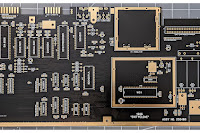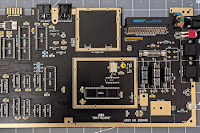
The user guide that came with my ILC Camera is nearly 400 pages long. And it's all in English. So that's 400 full pages of useful information to absorb. However, 400 is a pretty large number when it comes to pages and if you think I was ever going to read all of them then you don't know me very well at all. Consequently, when I first noticed a strange rubber flap near the battery compartment of my camera, it was something of a puzzle. But rather than investigate the manual and find out what this curious flap was, I just remained ignorant, and lazy. It didn't didn't get in the way or impede anything, it was just there, enigmatically.
Time passes. Three years to be precise. I am once again in the back garden taking pictures of the night sky and I quietly wonder to myself how long the little battery in the camera would last in the sub zero temperatures I was then enduring. If I was out for 3 or 4 hours repeatedly taking photos would it cope? And if it didn't and I had to replace it, that would mean disturbing my setup and potentially ruining what I was doing (messing around with a new wide angle lens if you really must know). This wondering led to some investigating and very suddenly everything fell into place.
 |
| The DC Cord Hole Cover |
Yes that little flap has a name. It's the DC Cord Hole Cover. And it is specifically designed to allow you to plug in an adaptor in place of your battery which will allow you to power the camera either from a household source, or, as in this instance, a USB power bank. You will need to buy an adaptor kit, and that 400 page manual I never bothered finishing even told me the name of the adaptor I'd need to make my internet searches fruitful. It is very likely your camera manual contains the same information should this be an avenue you want to explore.
 |
| DC Adaptor USB Cable |
The adaptor set consists of a cable with a USB A connector at one end, and a small power jack at the other, and this jack plugs into a Dummy Battery which makes the whole set fit into, and power your camera. Obviously camera battery designs vary from brand to brand and model to model so you need to be sure and get an adaptor specifically designed for your camera.
 |
| Plug in the Dummy Battery |
Once the jack is connected to the dummy battery, you simply insert it into your camera's battery compartment and gently pull the cord through the DC Cord Hole Cover then close the battery compartment door as follows:
As you can see from the above pictures, the result is a very neat cord solution that won't get in the way of L-Brackets or tripod mounts. Finally, attach the USB connector to a power bank, and as sure as eggs is eggs we now have a camera that will run for hours no problem. If I keep the power bank in a pocket next to my body it will stay warm and I shouldn't have to worry about battery drain during long cold nights of shooting.
 |
| The camera plugged in to a power bank |
And there we are, another great mystery solved and a solution to a problem found. If you knew this already then fine, you're smarter than I am and you have a great deal of company I assure you. But, if you've never quite made it through your own camera manual then hopefully this wee tip will be of some use.






